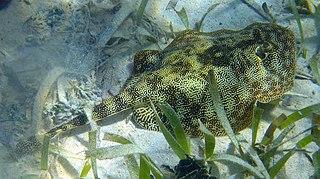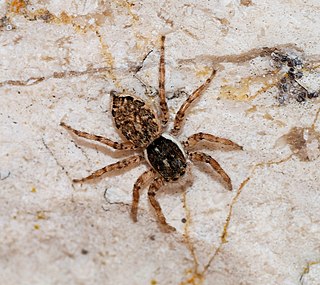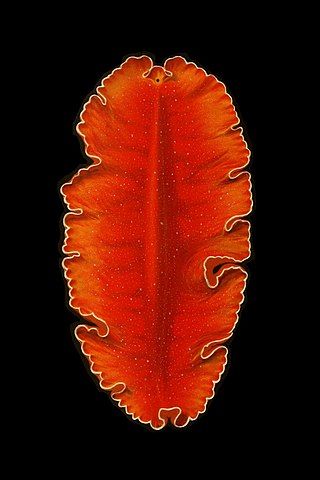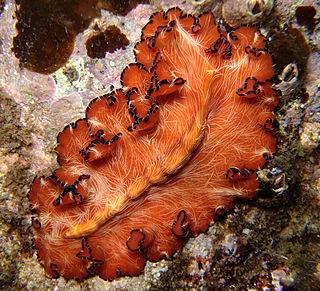
Amphibians are ectothermic, anamniotic, four-limbed vertebrate animals that constitute the class Amphibia. In its broadest sense, it is a paraphyletic group encompassing all tetrapods excluding the amniotes. All extant (living) amphibians belong to the monophyletic subclass Lissamphibia, with three living orders: Anura, Urodela (salamanders), and Gymnophiona (caecilians). Evolved to be mostly semiaquatic, amphibians have adapted to inhabit a wide variety of habitats, with most species living in freshwater, wetland or terrestrial ecosystems. Their life cycle typically starts out as aquatic larvae with gills known as tadpoles, but some species have developed behavioural adaptations to bypass this.

The giant panda, also known as the panda bear or simply panda, is a bear species endemic to China. It is characterised by its black-and-white coat and rotund body. The name "giant panda" is used to distinguish it from the distantly related red panda. Adult individuals average 100 to 115 kg, and are typically 1.2 to 1.9 m long. The species is sexually dimorphic, as males are typically 10 to 20% larger. The fur is white, with black patches around the eyes, ears, legs and shoulders. A thumb is visible on the bear's forepaw, which helps in holding bamboo in place for feeding. Giant pandas have adapted larger molars and expanded temporal fossa to meet their dietary requirements.

Onychophora, commonly known as velvet worms or more ambiguously as peripatus, is a phylum of elongate, soft-bodied, many-legged animals. In appearance they have variously been compared to worms with legs, caterpillars, and slugs. They prey upon other invertebrates, which they catch by ejecting an adhesive slime. Approximately 200 species of velvet worms have been described, although the true number of species is likely greater. The two extant families of velvet worms are Peripatidae and Peripatopsidae. They show a peculiar distribution, with the peripatids being predominantly equatorial and tropical, while the peripatopsids are all found south of the equator. It is the only phylum within Animalia that is wholly endemic to terrestrial environments, at least among extant members. Velvet worms are generally considered close relatives of the Arthropoda and Tardigrada, with which they form the proposed taxon Panarthropoda. This makes them of palaeontological interest, as they can help reconstruct the ancestral arthropod. Only two fossil species are confidently assigned to as onychophorans: Antennipatus from the Late Carboniferous, and Cretoperipatus from the Late Cretaceous, the latter belonging to Peripatidae. In modern zoology, they are particularly renowned for their curious mating behaviours and the bearing of live young in some species.

A dragonfly is a flying insect belonging to the infraorder Anisoptera below the order Odonata. About 3,000 extant species of dragonflies are known. Most are tropical, with fewer species in temperate regions. Loss of wetland habitat threatens dragonfly populations around the world. Adult dragonflies are characterised by a pair of large, multifaceted, compound eyes, two pairs of strong, transparent wings, sometimes with coloured patches, and an elongated body. Many dragonflies have brilliant iridescent or metallic colours produced by structural coloration, making them conspicuous in flight. An adult dragonfly's compound eyes have nearly 24,000 ommatidia each.

Sperm competition is the competitive process between spermatozoa of two or more different males to fertilize the same egg during sexual reproduction. Competition can occur when females have multiple potential mating partners. Greater choice and variety of mates increases a female's chance to produce more viable offspring. However, multiple mates for a female means each individual male has decreased chances of producing offspring. Sperm competition is an evolutionary pressure on males, and has led to the development of adaptations to increase male's chance of reproductive success. Sperm competition results in a sexual conflict between males and females. Males have evolved several defensive tactics including: mate-guarding, mating plugs, and releasing toxic seminal substances to reduce female re-mating tendencies to cope with sperm competition. Offensive tactics of sperm competition involve direct interference by one male on the reproductive success of another male, for instance by mate guarding or by physically removing another male's sperm prior to mating with a female. For an example, see Gryllus bimaculatus.

The Polycladida represents a highly diverse clade of free-living marine flatworms. They are known from the littoral to the sublittoral zone, and many species are common from coral reefs. Only a few species are found in freshwater habitats.
This glossary of ichthyology is a list of definitions of terms and concepts used in ichthyology, the study of fishes.

The masked palm civet, also called the gem-faced civet or Himalayan palm civet, is a viverrid species native to the Indian subcontinent and Southeast Asia. It has been listed as least concern on the IUCN Red List since 2008 as it occurs in many protected areas, is tolerant to some degree of habitat modification, and widely distributed with presumed large populations that are unlikely to be declining.

Pseudocerotidae is a family of flatworms which includes the Bedford's flatworm. Pseudocerotidae are simple organisms categorized by their oval bodies and tentacles and bright colors. They use the cilia to glide along surfaces. Most commonly referred to as marine flatworms, closely related to the orders Macrostomorpha and Lecithoepitheliata. These organisms have very complex reproductive systems, no blood systems or organs for gas exchange, a simple brain and are hermaphroditic.

The yellow stingray is a species of stingray in the family Urotrygonidae, found in the tropical western Atlantic Ocean from North Carolina to Trinidad. This bottom-dwelling species inhabits sandy, muddy, or seagrass bottoms in shallow inshore waters, commonly near coral reefs.

Insect morphology is the study and description of the physical form of insects. The terminology used to describe insects is similar to that used for other arthropods due to their shared evolutionary history. Three physical features separate insects from other arthropods: they have a body divided into three regions, three pairs of legs, and mouthparts located outside of the head capsule. This position of the mouthparts divides them from their closest relatives, the non-insect hexapods, which include Protura, Diplura, and Collembola.

Pseudobiceros bedfordi is a species of flatworm in the family Pseudocerotidae.
Maritigrella crozierae, the tiger flatworm, is a species of marine polyclad flatworm in the family Euryleptidae. It is found on the eastern coasts of North America and the Caribbean Sea where it feeds on colonial sea squirts.

The carpet flatworm is a polyclad flatworm in the family Pseudocerotidae.

Menemerus animatus is a species of jumping spider in the genus Menemerus that lives across the Mediterranean Basin and into the Afrotropical realm. The species was first described in 1876 by Octavius Pickard-Cambridge based on an example from Egypt. It has subsequently been found living across many countries from Algeria to Greece and Senegal to Yemen. It prefers living in sandy environments.
Agelenopsis pennsylvanica, commonly known as the Pennsylvania funnel-web spider or the Pennsylvania grass spider, is a species of spider in the family Agelenidae. The common name comes from the place that it was described, Pennsylvania, and the funnel shape of its web. Its closest relative is Agelenopsis potteri.
Pseudoceros canadensis, commonly known as the Puget flatworm, is a species of free-living flatworm in the genus Pseudoceros, belonging to the family Pseudocerotidae.

Leucauge mariana is a long-jawed orb weaver spider, native to Central America and South America. Its web building and sexual behavior have been studied extensively. Males perform several kinds of courtship behavior to induce females to copulate and to use their sperm.

Yungia aurantiaca is a species of flatworm in the family Pseudocerotidae. It is found in the temperate northeastern Atlantic Ocean and the Mediterranean Sea.

Pseudobiceros fulgor, also known the lightning worm, is a species of marine flatworm from the family Pseudocerotidae and belongs to the class Turbellaria. These flatworms are commonly found in the tropics of the Indo-Pacific region. They can be found in shallow coral reef environments.




















